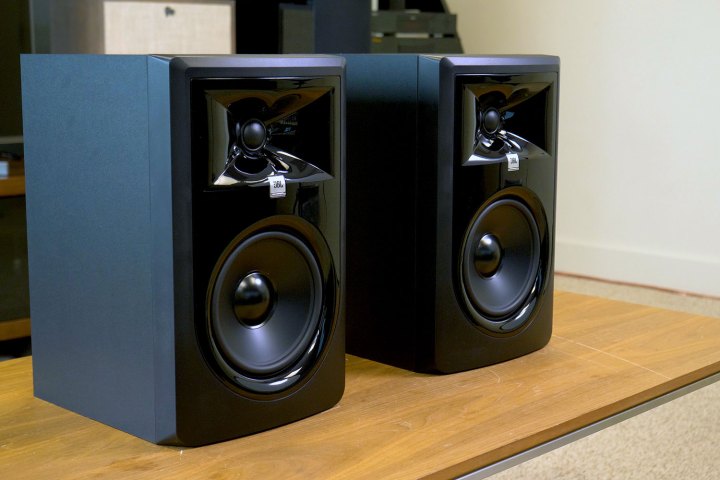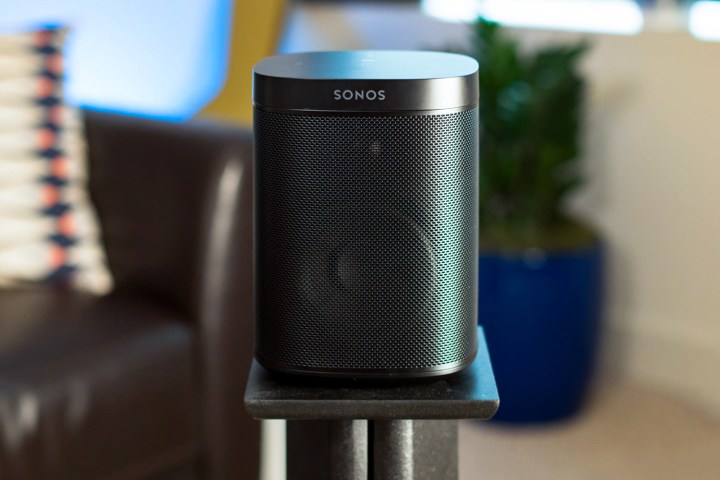Elac Uni-Fi UB5
The best speakers overall
Why you should buy them: Insane sound quality from compact, affordable speakers.
Who they’re for: Audio lovers with smaller rooms, serious listeners without corner office salaries.
Why we picked the Elac Uni-Fi UB5:
Noted speaker engineer Andrew Jones pulled out all the stops when he designed Elac’s Uni-Fi UB5 model, placing the company’s acclaimed concentric driver design — where the speaker’s tweeter sits in a 4-inch midrange driver — inside an affordable bookshelf model.
That concentric driver, which is known for enhancing clarity, combines with a 5.25-inch bass driver to offer flat and dynamic response regardless of what you’re listening to. Few bookshelf speakers have the elegant balance and remarkable accuracy of the UB5, and we’re downright astonished that this level of sound is available at the price point. In addition to great sound, silver accents adorn the outside of each speaker cone, providing an elegant look that will fit in even the fanciest living rooms, and solid construction means they should last a lifetime.
You don’t have to take our word that the Uni-Fi UB5 are an astonishing set of speakers for the money; with audiophiles around the world raving about their incredible sound quality, it’s about as close to objective truth as these things come. Whether you’ve got a small room or a tight budget, these speakers are the best on the market right now, and you’ll never regret owning a pair, even if you upgrade to something larger down the road.
Klipsch Reference Bookshelf
The best budget speakers
Why you should buy them: Few speakers balance looks, performance, and budget as deftly as the Klipsch Reference line.
Who they’re for: Those who want a smaller factor set of speakers without compromising on sound quality or breaking the bank.
Why we picked the Klipsch Reference Bookshelf:
Klipsch has a history of delivering top-notch speakers, and its Reference line has long been seen as the company’s sweet spot: Well-engineered, beautifully designed, and very competitive on price. Klipsch’s engineers went back to the drawing board and rebuilt the Reference line from the ground up, instead of opting for some minor tweaks to the existing design. The result is an improved sound signature across the line, including the bookshelf models. While the Reference Bookshelf speakers come in powered and non-powered flavors, we recommend the non-powered models because, for most people, they pack everything you need for great sound without adding things like amplification at extra expense.
As a compact set of full-range speakers, the Reference Bookshelf makes for the perfect upgrade path. You can start using them as the primary stereo pair for a small-to-medium size room — perhaps with a connected amp like the Sonos Amp — and then migrate them as you build out a larger home theater setup. They’re powerful enough to act as your primary front left/right speakers in a basic 5.1 or 5.1.2 home theater, but small enough that they can be assigned the role of rear satellite speakers if you decide to upgrade your front channels with full-size tower speakers.
JBL 306P MKII
The best speakers for home recording

Why you should buy them: Flat, studio-style sound
Who they’re for: Musicians, podcasters, videographers, and other creative hobbyists who regularly work with audio.
Why we picked the JBL 306P MkII:
If you’re a content creator who works with audio, be it editing a podcast, recording demos in your bedroom, or producing YouTube videos, you need a revealing set of speakers with very flat frequency response to make sure your sound will translate well anywhere your listeners will hear it. While we’d have previously said JBL’s LSR305s were the ticket, we’ll be darned if the company didn’t come out with something even better to get your studio gears churning.
Like their predecessor, the JBL 306P MkII offer the kind of sound signature you expect in a professional studio, but at a shockingly affordable price, and provide you with an extremely useful tool with which to create. In fact, we like the 306P even better thanks to a fuller 6-inch woofer, which offers bigger bass response for even more accurate mixing than the previous 5-inch woofer.
That new 6-inch woofer (the middle size in the new line) combines with a 1-inch silk dome tweeter to provide a remarkable full-spectrum response on each side, and with improved waveguide technology, you’ll get an even wider stereo image that allows you to pan your mixes with impressive detail. Volume isn’t a problem either, with plenty of amplification on board providing enough power to fill the vast majority of spaces, and certainly enough for near-field listening — which is what these speakers were designed for.
It’s worth noting that, like the LSR305, the 306P MkII only have balanced XLR and TRS inputs, meaning you’ll probably want an audio interface — an outboard component that typically has these outputs, as well as microphone inputs — to get your sound to them. Those interested in using the powered JBLs outside of home studios can do so with some RCA adapters, but an interface is still the best route.
If you’re a creative type who wants to get the most out of your projects, JBL’s 306P MkII speakers are tough to beat, ranking among the best value propositions in speaker land.
Sonos One
The best Wi-Fi speaker

Why you should buy it: The Sonos One is an affordable, great-sounding way to start building your whole-home Wi-Fi audio system.
Who it’s for: Those who want the convenience of wireless sound with the benefits of a smart speaker.
Why we picked the Sonos One:
Followers of this list will know we’ve gone back and forth on this one. For a while, the Riva Concert claimed this title, but as we often do, we’ve revised that selection. As much as we love the Riva Concert’s sound and excellent connectivity options, the company has failed to deliver on a whole-home multiroom experience for its buyers. If we were contemplating using a Wi-Fi speaker on its own, maybe that wouldn’t bother us so much. But whole-home audio is a big reason to go Wi-Fi in the first place. And no one does multiroom better than Sonos.
The Sonos One sounds terrific and pumps out the kind of room-filling audio that still turns heads. You also get your pick of Alexa or Google Assistant if you want to use it as a smart speaker (or keep the mic turned off — it’s up to you). It also has AirPlay 2, which while not quite as flexible as Bluetooth, is nonetheless a huge win for Apple users who want to get better sound from their iOS devices. In fact, its lack of Bluetooth is our only real beef with the One.
The Sonos app is the key to this system. Always improving,
How we test
We test speakers the way normal people live.
We run every speaker through a rigorous process over the course of several days or weeks. That includes playing them in all sorts of scenarios, be it in the listening room, computer room, or at the office, and playing back from our device library, CDs, vinyl, and streaming services.
For wireless speakers, we also test range, connection stability, and interference in areas with a lot of radio frequency interference (i.e. the Digital Trends offices). For non-powered speaker models, we listen via a variety of amplifiers, ensuring we have a good idea of what each model is doing given different power and sources.
Finally, we compare each speaker to some of our go-to models, both in their class and price point, as well as a level or two above to find out if they can punch above their weight. This ensures that we are putting them in perspective with the larger industry, and also cements the way that we think about the price-to-performance ratio of each speaker we test.



